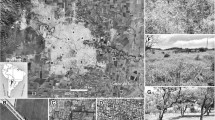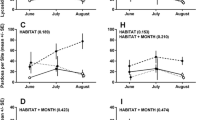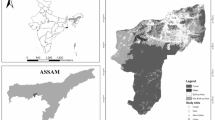Abstract
Broad-scale modification of natural ecosystems associated with urbanisation often leads to localised extinctions and reduced species richness. Despite this, habitats within the urban matrix are still capable of supporting biodiversity to varying degrees. As species have different responses to anthropogenic habitat modification, the species composition of urban areas can depend greatly on the habitat characteristics of the local and surrounding areas. The aim of this study was to compare the community composition of spiders in private gardens, urban parks, patches of remnant vegetation and continuous bushland sites, so as to identify habitat variables associated with variation in spider populations along and within the urban gradient and matrix. Overall spider abundances and richness were highest in remnant vegetation patches and were associated with increased vegetation cover at microhabitat and landscape-scales. While gardens were not as diverse as remnant patches, they did support a surprisingly high diversity of spiders. We also found that species composition differed significantly between gardens and other urban green spaces. Higher richness within gardens was also associated with greater vegetation cover, indicating the importance of private management decisions on local biodiversity. Differences in community composition between land-use types were driven by a small number of urban-tolerant species, and spider guilds showed different responses to habitat traits such as vegetation cover and human population densities. This study demonstrates that urban land-uses support unique spider communities and that maintaining vegetation cover within the urban matrix is essential in order to support diverse spider communities in cities.





Similar content being viewed by others
References
Alaruikka D, Kotze DJ, Matveinen K, Niemelä J (2002) Carabid beetle and spider assemblages along a forested urban–rural gradient in southern Finland. J Insect Conserv 6:195–206. https://doi.org/10.1023/a:1024432830064
Bang C, Faeth SH (2011) Variation in arthropod communities in response to urbanization: seven years of arthropod monitoring in a desert city. Lands Urban Plan 103:383–399. https://doi.org/10.1016/j.landurbplan.2011.08.013
Bates D, Mächler M, Bolker B, Walker S (2015) Fitting linear mixed-effects models using lme4. arXiv preprint arXiv:1406.5823
Beninde J, Veith M, Hochkirch A (2015) Biodiversity in cities needs space: a meta-analysis of factors determining intra-urban biodiversity variation. Ecol Lett 18:581–592. https://doi.org/10.1111/ele.12427
Bivand R, Piras G (2015) Comparing implementations of estimation methods for spatial econometrics. J Stat Soft 63(18):1–36
Bolger DT, Suarez AV, Crooks KR, Morrison SA, Case TJ (2000) Arthropods in urban habitat fragments in southern California: area, age, and edge effects. Ecol Appl 10:1230–1248. https://doi.org/10.1890/1051-0761(2000)010[1230:AIUHFI]2.0.CO;2
Bolger DT, Beard KH, Suarez AV, Case TJ (2008) Increased abundance of native and non-native spiders with habitat fragmentation. Diverse Distrib 14:655–665. https://doi.org/10.1111/j.1472-4642.2008.00470.x
Burkman CE, Gardiner MM (2014) Urban greenspace composition and landscape context influence natural enemy community composition and function. Biol Control 75:58–67
Burkman CE, Gardiner MM (2015) Spider assemblages within greenspaces of a deindustrialized urban landscape. Urban Ecosyst 18:793–818. https://doi.org/10.1007/s11252-014-0430-8
Burnhan KP, Anderson DR (2002) Model selection and multimodel inference: a practical information-theoretic approach, 2nd edn. Springer, New York
Cardoso P, Pekár S, Jocqué R, Coddington JA (2011) Global patterns of guild composition and functional diversity of spiders. PLoS ONE 6:e21710. https://doi.org/10.1371/journal.pone.0021710
Churchill TB, Arthur JM (1999) Measuring spider richness: effects of different sampling methods and spatial and temporal scales. J Insect Conserv 3:287–295. https://doi.org/10.1023/a:1009638706789
Clarke K, Gorley R (2015) PRIMER, 7th edn. Plymouth Marine Laboratory, Plymouth
Clough Y, Kruess A, Kleijn D, Tscharntke T (2005) Spider diversity in cereal fields: comparing factors at local, landscape and regional scales. J Biogeogr 32:2007–2014. https://doi.org/10.1111/j.1365-2699.2005.01367.x
Cobbold SM, MacMahon JA (2012) Guild mobility affects spider diversity: links between foraging behavior and sensitivity to adjacent vegetation structure. Basic Appl Ecol 13:597–605. https://doi.org/10.1016/j.baae.2012.08.014
De Mas E, Chust G, Pretus J, Ribera C (2009) Spatial modelling of spider biodiversity: matters of scale. Biodivers Conserv 18:1945–1962. https://doi.org/10.1007/s10531-008-9566-2
Denno RF, Finke DL, Langellotto GA (2005) Direct and indirect effects of vegetation structure and habitat complexity on predator–prey and predator–predator interactions. In: Barbosa P, Castellanos I (eds) Ecology of predator-prey interactions. Oxford University Press, London, pp 211–239
Diehl E, Mader V, Wolters V, Birkhofer K (2013) Management intensity and vegetation complexity affect web-building spiders and their prey. Oecologia 173:579–589. https://doi.org/10.1007/s00442-013-2634-7
Faeth SH, Warren PS, Shochat E, Marussich WA (2005) Trophic dynamics in urban communities. Bioscience 55:399–407. https://doi.org/10.1641/0006-3568(2005)055[0399:tdiuc]2.0.co;2
Fischer JB, Lindenmayer D (2006) Beyond fragmentation: the continuum model for fauna research and conservation in human-modified landscapes. Oikos 112:473–480. https://doi.org/10.1111/j.0030-1299.2006.14148.x
Fischer J, Lindenmayer DB (2007) Landscape modification and habitat fragmentation: a synthesis. Glob Ecol Biogeogr 16:265–280. https://doi.org/10.1111/j.1466-8238.2007.00287.x
Gardiner MM, Burkman CE, Prajzner SP (2013) The value of urban vacant land to support arthropod biodiversity and ecosystem services. Environ Entomol 42:1123–1136. https://doi.org/10.1603/en12275
Gaston K, Warren P, Thompson K, Smith R (2005) Urban domestic gardens (IV): the extent of the resource and its associated features. Biodivers Conserv 14:3327–3349. https://doi.org/10.1007/s10531-004-0513-6
Gaston KJ et al (2007) Improving the contribution of urban gardens for wildlife: some guiding propositions. Brit Wildlife 18:171–177
Geiger F et al (2010) Persistent negative effects of pesticides on biodiversity and biological control potential on European farmland. Basic Appl Ecol 11:97–105. https://doi.org/10.1016/j.baae.2009.12.001
Goddard MA, Dougill AJ, Benton TG (2010) Scaling up from gardens: biodiversity conservation in urban environments. Trends Ecol Evol 25:90–98. https://doi.org/10.1016/j.tree.2009.07.016
Goncalves-Souza T, Almeida-Neto M, Romero GQ (2011) Bromeliad architectural complexity and vertical distribution predict spider abundance and richness. Aust Ecol 36:476–484. https://doi.org/10.1111/j.1442-9993.2010.02177.x
Haase D et al (2014) A quantitative review of urban ecosystem service assessments: concepts, models, and implementation. Ambio 43:413–433. https://doi.org/10.1007/s13280-014-0504-0
Hothorn T, Bretz F, Westfall P (2008) Simultaneous inference in general parametric models. Biom J 50:346–363. https://doi.org/10.1002/bimj.200810425
Kark S, Iwaniuk A, Schalimtzek A, Banker E (2007) Living in the city: can anyone become an ‘urban exploiter’? J Biogeogr 34:638–651. https://doi.org/10.1111/j.1365-2699.2006.01638.x
Kendal D, Williams N, Williams K (2010) Harnessing diversity in gardens through individual decision makers. Trends Ecol Evol 25:201–202. https://doi.org/10.1016/j.tree.2009.12.006
Kendal D, Williams NSG, Williams KJH (2012) Drivers of diversity and tree cover in gardens, parks and streetscapes in an Australian city. Urban For Urban Gree 11:257–265. https://doi.org/10.1016/j.ufug.2012.03.005
Kralj-Fišer S, Schneider JM (2012) Individual behavioural consistency and plasticity in an urban spider. Anim Behav 84:197–204. https://doi.org/10.1016/j.anbehav.2012.04.032
Loram A, Warren P, Gaston K (2008) Urban domestic gardens (XIV): the characteristics of gardens in five cities. Environ Manag 42:361–376. https://doi.org/10.1007/s00267-008-9097-3
Lowe EC, Wilder SM, Hochuli DF (2014) Urbanisation at multiple scales is associated with larger size and higher fecundity of an orb-weaving spider. PLoS ONE 9:e105480. https://doi.org/10.1371/journal.pone.0105480
Lowe EC, Wilder SM, Hochuli DF (2016) Persistence and survival of the spider Nephila plumipes in cities: do increased prey resources drive the success of an urban exploiter? Urban Ecosyst 19:705–720. https://doi.org/10.1007/s11252-015-0518-9
Magura T, Tóthmérész B, Hornung E, Horváth R (2008) Urbanisation and ground-dwelling invertebrates. In: Wagner LN (ed) Urbanization: 21st century issues and challenges. Nova Publishers, New York
Mazerolle MJ (2015) AICcmodavg: model selection and multimodel inference based on (Q)AIC(c). R package version 2.0-3
McDonnell MJ, Pickett STA (1990) Ecosystem structure and function along urban-rural gradients: an unexploited opportunity for ecology. Ecology 71:1232–1237. https://doi.org/10.2307/1938259
McIntyre NE (2000) Ecology of urban arthropods: a review and a call to action. Ann Entomol Soc Am 93:825–835. https://doi.org/10.1603/0013-8746(2000)093[0825:eouaar]2.0.co;2
McKinney ML (2006) Urbanization as a major cause of biotic homogenization. Biol Conserv 127:247–260. https://doi.org/10.1016/j.biocon.2005.09.005
McKinney M (2008) Effects of urbanization on species richness: a review of plants and animals. Urban Ecosyst 11:161–176. https://doi.org/10.1007/s11252-007-0045-4
Miyashita T, Shinkai A, Chida T (1998) The effects of forest fragmentation on web spider communities in urban areas. Biol Conserv 86:357–364. https://doi.org/10.1016/s0006-3207(98)00025-1
Miyashita T, Chishiki Y, Takagi SR (2012) Landscape heterogeneity at multiple spatial scales enhances spider species richness in an agricultural landscape. Popul Ecol 54:573–581. https://doi.org/10.1007/s10144-012-0329-2
Otoshi MD, Bichier P, Philpott SM (2015) Local and landscape correlates of spider activity density and species richness in urban gardens. Environ Entomol 44:1043–1051. https://doi.org/10.1093/ee/nvv098
Paker Y, Yom-Tov Y, Alon-Mozes T, Barnea A (2014) The effect of plant richness and urban garden structure on bird species richness, diversity and community structure. Landsc Urban Plan 122:186–195. https://doi.org/10.1016/j.landurbplan.2013.10.005
Pauleit S, Ennos R, Golding Y (2005) Modeling the environmental impacts of urban land use and land cover change—a study in Merseyside, UK. Lands Urban Plan 71:295–310. https://doi.org/10.1016/j.landurbplan.2004.03.009
R Core Team (2015) R: a language and environment for statistical computing. R Foundation for Statistical Computing, Vienna
Rasband WS (2015) ImageJ, v 1.48. National Institutes of Health, Bethesda
Raupp MJ, Shrewsbury PM, Herms DA (2010) Ecology of herbivorous arthropods in urban landscapes. Annu Rev Entomol 55:19–38. https://doi.org/10.1146/annurev-ento-112408-085351
Sattler T, Borcard D, Arlettaz R, Bontadina F, Legendre P, Obrist MK, Moretti M (2010) Spider, bee, and bird communities in cities are shaped by environmental control and high stochasticity. Ecology 91:3343–3353. https://doi.org/10.1890/09-1810.1
Shochat E, Stefanov WL, Whitehouse MEA, Faeth SH (2004) Urbanization and spider diversity: influences of human modification of habitat structure and productivity. Ecol Appl 14:268–280. https://doi.org/10.1890/02-5341
Smith R, Gaston K, Warren P, Thompson K (2006a) Urban domestic gardens (VIII): environmental correlates of invertebrate abundance. Biodivers Conserv 15:2515–2545. https://doi.org/10.1007/s10531-005-2784-y
Smith RM, Warren PH, Thompson K, Gaston KJ (2006b) Urban domestic gardens (VI): environmental correlates of invertebrate species richness. Biodivers Conserv 15:2415–2438. https://doi.org/10.1007/s10531-004-5014-0
Trubl P, Gburek T, Miles L, Johnson J (2012) Black widow spiders in an urban desert: population variation in an arthropod pest across metropolitan Phoenix, AZ. Urban Ecosyst 15:599–609. https://doi.org/10.1007/s11252-011-0223-2
Turrini T, Knop E (2015) A landscape ecology approach identifies important drivers of urban biodiversity. Glob Change Biol 21:1652–1667. https://doi.org/10.1111/gcb.12825
Uetz GW (1991) Habitat structure and spider foraging. In: Bell SS, McCoy ED, Mushinsky HR (eds) Habitat structure: the physical arrangement of objects in space. Springer, Dordrecht, pp 325–348. https://doi.org/10.1007/978-94-011-3076-9_16
van Heezik Y, Freeman C, Porter S, Dickinson KJM (2013) Garden size, householder knowledge, and socio-economic status influence plant and bird diversity at the scale of individual gardens. Ecosystems 16:1442–1454. https://doi.org/10.1007/s10021-013-9694-8
Varet M, Pétillon J, Burel F (2011) Comparative responses of spider and carabid beetle assemblages along an urban-rural boundary gradient. J Arachnol 39:236–243. https://doi.org/10.1636/cp10-82.1
Vergnes A, Viol IL, Clergeau P (2012) Green corridors in urban landscapes affect the arthropod communities of domestic gardens. Biol Conserv 145:171–178. https://doi.org/10.1016/j.biocon.2011.11.002
Acknowledgements
We thank the NSW National Parks and Wildlife Service, the Royal Botanic Gardens and local councils for the permission to sample in their areas. We also thank N. Cooper and the team at Systems Pest Management for their support, and the owners of the gardens for allowing us to conduct our surveys on their properties. CGT is supported by the Clean Air and Urban Landscapes Hub, which is funded by the Australian Government’s National Environmental Science Programme.
Author information
Authors and Affiliations
Corresponding author
Additional information
Communicated by Peter J. T. White.
This article belongs to the Topical Collection: Urban biodiversity.
Electronic supplementary material
Below is the link to the electronic supplementary material.
Rights and permissions
About this article
Cite this article
Lowe, E.C., Threlfall, C.G., Wilder, S.M. et al. Environmental drivers of spider community composition at multiple scales along an urban gradient. Biodivers Conserv 27, 829–852 (2018). https://doi.org/10.1007/s10531-017-1466-x
Received:
Revised:
Accepted:
Published:
Issue Date:
DOI: https://doi.org/10.1007/s10531-017-1466-x




